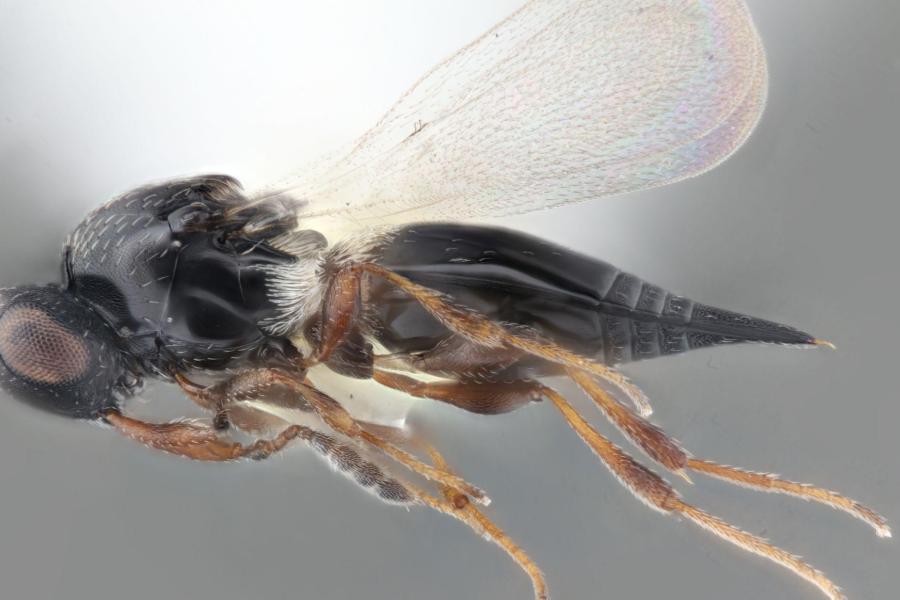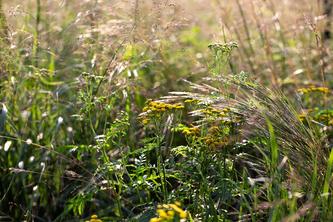
MINNEAPOLIS/ST. PAUL (05/11/2023) — Researchers at the University of Minnesota have discovered a new species of tiny parasitic wasp that might prove beneficial to managing soybean gall midge, a recently emerged pest in Midwest soybean fields that can have devastating impacts on plant production.
Their findings were recently published in the Journal of Hymenoptera Research.
Since the appearance of the midge in 2018, growers have struggled to manage this insect, prompting researchers to seek effective and environmentally-friendly ways to help soybean farmers protect their crop. One approach is biological control, using natural enemies to kill pests. However, because soybean gall midge is new, very little is known about which species might prove to be good allies to growers in the fight against this damaging insect.
Amelia Lindsey, an assistant professor in the Department of Entomology, and Robert Koch, an associate professor in the Department of Entomology and an Extension entomologist, led the team at the University of Minnesota. They focused on searching for parasitoids — insects that lay their eggs in or on another insect — of soybean gall midge. Juveniles of the parasitoid develop inside the other insect, eventually killing them.
To find such parasitic insects, a graduate student in the Lindsey and Koch labs, Gloria Melotto, collected soybean gall midge-infested plants from a Minnesota farm and waited to see which adult insects emerged from the plants.
The researchers found:
- In addition to a lot of soybean gall midges, there were a number of tiny parasitoid wasps.
- In collaboration with two taxonomists who specialize in this group of insects—Jessica Awad, doctoral researcher, State Museum of Natural History Stuttgart, and Elijah Talamas, Florida Department of Agriculture and Consumer Services—it became clear that there was no information on this wasp anywhere in the scientific record. It is a new-to-science species.
- The team used DNA sequencing data and physical characteristics of the wasps to formally describe the specimens and give them a scientific name: Synopeas maximum.
- The findings point toward this newly described parasitoid wasp species being a likely natural enemy of soybean gall midge.
“Unidentified and undescribed parasitoid micro-wasps are all around us. Although they are tiny, they play a huge role in regulating the populations of other insects, including pests. It’s really exciting to discover a new parasitoid species in such an important crop system," said Awad.
"Effective management of soybean gall midge has proven challenging. Identification of a new species of parasitic wasp attacking this pest is an exciting breakthrough,” said Koch.
Ongoing work from the team includes a deeper dive into the biology of the wasp and the soybean gall midge to see how often this wasp attacks the pest, and how widespread this potential beneficial insect is across the midwest. Ultimately, the goal is to develop strategies for incorporating the natural enemy into management plans for safe and effective control of soybean gall midge infestations.
This research was supported by the Minnesota Rapid Agricultural Response Fund.
About the College of Food, Agricultural and Natural Resource Sciences
The University of Minnesota’s College of Food, Agricultural and Natural Resource Sciences (CFANS) strives to inspire minds, nourish people, and sustainably enhance the natural environment. CFANS has a legacy of innovation, bringing discoveries to life through science and educating the next generation of leaders. Every day, students, faculty, and researchers use science to address the grand challenges of the world today and in the future. CFANS offers an unparalleled expanse of experiential learning opportunities for students and the community, with 12 academic departments, 10 research and outreach centers across the state, the Minnesota Landscape Arboretum, the Bell Museum of Natural History, and dozens of interdisciplinary centers. Learn more at cfans.umn.edu.
- Categories:
- Agriculture and Environment





